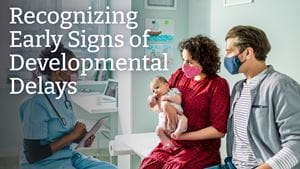
Approximately one out of every six children in the United States has a developmental delay or a developmental disability. These can affect how a child plays, moves, acts, speaks, or learns.
As a pediatrician, Chantal Keizer, MD, knows what to look for with signs of developmental delays in young children. She explains what to look for and when.
A developmental delay occurs when a child has not yet reached certain developmental milestones within an expected age range.
Most milestones happen within the first two years of a child’s life. These focus on cognitive, social, emotional, behavioral, and speech development – as well as motor skills. The CDC lists the most common developmental milestones and the ages at which they are likely to happen.
During the first year of a child’s life, his or her pediatrician will go over standard developmental milestones with the parent or caregiver. General developmental screenings are recommended by the American Academy of Pediatrics at 9, 18, and 30 months. If a parent or caregiver has a concern, they are encouraged to ask their pediatrician.
Developmental delays can exist in a single specific area or can be spread across a spectrum of categories. These are some of the areas and how they manifest in children.
Delays in this area affect a child’s intellectual functioning. While some children may exhibit behaviors earlier than others, signs of cognitive developmental delays become more apparent around the ages of 4-6 when children begin going to school consistently.
For example, some children may have difficulty communicating and playing with other children to the point where it inhibits their functioning.
Some of the causes may include:
These can interfere with a child learning to coordinate large and small muscle groups. For example, babies who take longer to roll over or crawl could have delays in this category of development.
This may also be the case for older children who might seem clumsy and have trouble with their fine motor skills. An older child may have difficulty holding onto their toothbrush or tying their shoes, for example.
Some of the diagnoses in this area include:
These delays come into play when a child’s ability to learn, communicate, or interact with others is inhibited. These differences in development affect how a child reacts to their environment.
Children may have trouble with:
These specific indicators can be signs of autism or Attention Deficit Hyperactivity Disorder (ADHD).
Delays in this area can be receptive, expressive, or both – meaning a child has trouble receiving or taking in speech, or expressing their thoughts and feelings through speech.
Receptive speech delays can be seen as having difficulty understanding words or concepts such as colors or shapes.
Expressive speech delays are recognized when a child has a lower vocabulary as compared to most children their age. For babies, they may be slow to babble. For young toddlers, they may be slow to talk and eventually form sentences.
Speech production disorder can manifest as low oromotor skills. These can stem from weak muscles in the mouth including the tongue or jaw, brain damage, or a genetic syndrome.
“It is possible to have more than one,” Dr. Keizer said. “A proper assessment is needed before we can refer a child to any interventional services.”
There are some factors that can place a child at increased risk for developmental delays. Some are hereditary; others are environmental.
During an initial screening, providers will ask about a patient’s family history to see if there are factors that could increase the risk of certain developmental conditions or disabilities. Some conditions, such as Fragile X syndrome, are passed down genetically.
Environmental risk factors can include:
“Every opportunity, every interaction with a child and their family is an assessment for growth and development,” Dr. Keizer said. “You don’t always wait for a well child visit in the office. Every opportunity is a time to assess a child.”
Vision and hearing screenings are conducted very early in a child’s development to determine early on if they could need early intervention services.
The most common way developmental delays are diagnosed is through parents reporting their child’s behaviors to their pediatrician.
The American Academy of Pediatrics recommends developmental screenings at the ages of 9, 18, 24, and 30 months. Screenings for autism are conducted at 18 and 24 months.
There are several ways a child is screened for developmental delays at various stages in their development. Screening questionnaires are given to parents to ask questions about a child’s behavior with scores that are broken down into ranges. The overall score gives insight into the needs for intervention for the child.
These screening tests and evaluations include:
“If we suspect a child may have some developmental delays or parents in the office raise a concern, then we can do a screening at that time,” Dr. Keizer said.
If a child fails any of the screenings mentioned above, they are referred to a pediatric developmental specialist.
From birth until age 3, any referrals for early intervention would be made to New York State’s Early Intervention Program through the Department of Health.
Starting at age 3, early intervention services can be given to the child through the public school system where a family resides. Part of that intervention may include developing an Individualized Education Plan (IEP). The child’s pediatrician will work with the school district to create that plan.
“The earlier you intervene, the better the likelihood for having a better outcome,” Dr. Keizer said.
Providers will refer children to other early intervention services as they are needed for different areas of their development. If you want to know more about those services, consult with your pediatrician.
Overall, parents should remember that development is a continuum – it does not happen all at once. If a child does not start walking by 12 months exactly, there is time for growth.